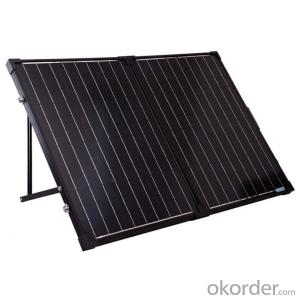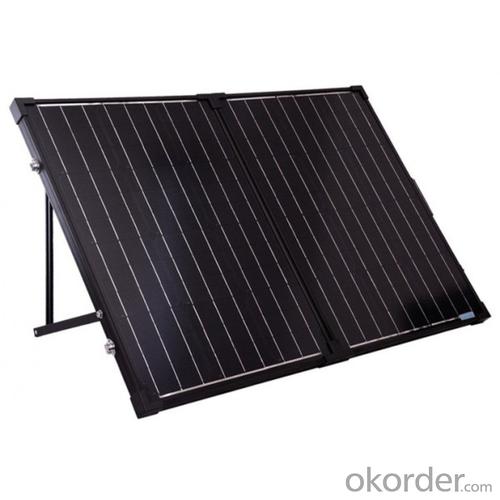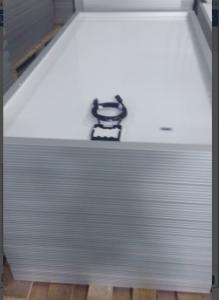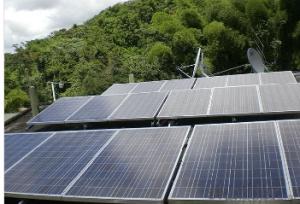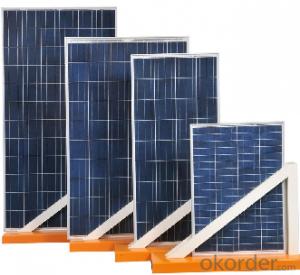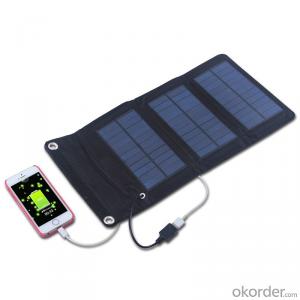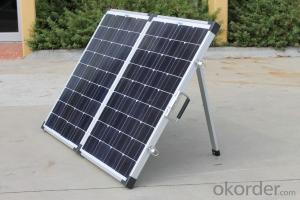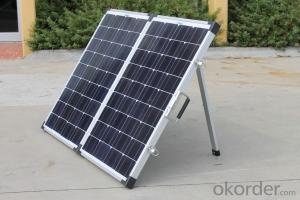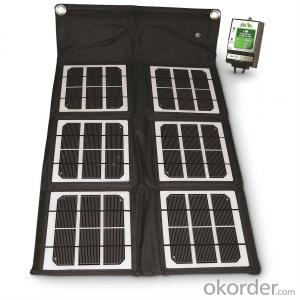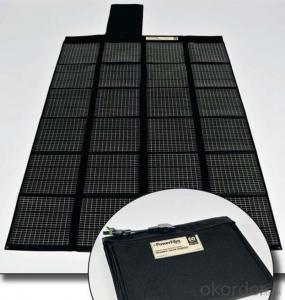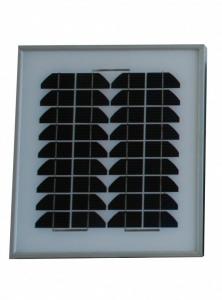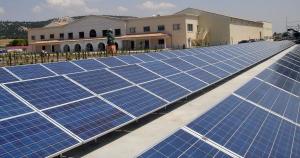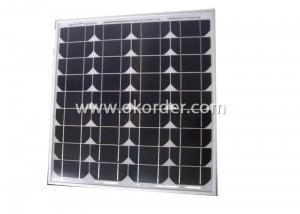200W Folding Solar Panel with Flexible Supporting Legs for 1000 Sq Ft Home Camping
- Loading Port:
- Shanghai
- Payment Terms:
- TT OR LC
- Min Order Qty:
- 1000 watt
- Supply Capability:
- 10000 watt/month
OKorder Service Pledge
OKorder Financial Service
You Might Also Like
Specification
Product Description
Folding module kits are designed to provide portable 12 volt power wherever you need it.PoPwer available from 20W to 240W
Features:
· Padded, moulded carry bag
· Heavy duty carry handle, hinges and clasps Stainless steel telescopic&adjustable legs
· Weatherproof solar charge controller with LED indicator
· 5m cable with heavy duty Anderson connectors between module-regulator & regulator-battery clamps
· All cabled up ready to use
· 2 year warranty
These kits are the ideal solution for 4WD, camping, caravaning, boating and recreational activities whereverpower is required for lights, small TV, camping fridge, pump or other small appliances.
| Nominal Peak Power | 200W | 120W (2 x 60W) | 160W (2 x 80W) | 200W (2 x 100W) |
| Power tolerance | 3% | |||
| Cell type | Monocrystalline/Polycrystalline | |||
| Open circuit voltage (Voc) | 21.6V | |||
| Voltage at maximum power (Vmp) | 17.6V | 17.5V | 17.5V | 17.5V |
| Short circuit current (Isc) | 4.9A | 7.4A | 9.88A | 12.34A |
| Current at maximum power (Imp) | 4.54A | 6.86A | 9.14A | 11.42A |
| Maximum system voltage | 1000VDC | |||
| NOCT (Nominal Operating Cell Temperature) | 45 C +/-2 C | |||
| Operating temperature - module | -40 C to +85 C | |||
| Operating temperature – charge | -35 C to +55 C | |||
| Module folded size (mm) in carry bag | 505x550x60 | 505x825x80 | 505x1005x70 | 670x1005x70 |
| Module open size (mm) | 1014x550x30 | 1014x825x35 | 1014x1005x35 | 1344x1005x35 |
| Module net weight (kg) | 9.2 | 13 | 15.2 | 19 |
| Module gross weight (kg) | 11 | 16 | 19.4 | 23.2 |
| Solar charge controller | PWM 12V 10A; IP65 rated | PWM 12V 20A; IP65 rated | ||
- Q: is this fact true? - its a limitation to solar panels during summer when it's in extremly hot countrie. I've heard it from my science teacher .. please give detail if you have any and any more benefits/limitations is welcomed .. Thank you :) !
- i couldn't see any evidence of that on the internet, but i only searched for a little while for ya. all i can say is in Australia 40 - 50 degrees celcious is about our hottest, and i have never heard of it being a problem. im sure that being the sunburnt country we would know as general knowledge if the solar systems didn't go well if it was too hot.
- Q: Can solar panels be used to power a public transportation system?
- Yes, solar panels can be used to power a public transportation system. By installing solar panels on the rooftops of public transportation vehicles or on charging stations at transit hubs, the energy generated from the sun can be harnessed to provide power for electric buses, trams, or trains. This reduces reliance on traditional energy sources and helps to make public transportation more sustainable and environmentally friendly.
- Q: How do solar panels affect the property's LEED certification?
- Solar panels can have a positive impact on a property's LEED certification by contributing towards earning points in various categories such as Energy and Atmosphere, Sustainable Sites, and Materials and Resources. Installing solar panels demonstrates a commitment to renewable energy and can help achieve higher levels of certification within the LEED rating system.
- Q: how efficient are flexible solar panels?
- Up to now, it has very poor efficiency, about 5% to 23%.
- Q: How much space do solar panels require?
- The space required for solar panels depends on several factors such as the power output of the panels and the efficiency of the solar cells. On average, a typical solar panel requires around 10-20 square feet of space. However, it is important to note that solar panels can be mounted on rooftops, installed in large solar farms, or even integrated into building materials, allowing for flexibility in their placement and utilization of available space.
- Q: Is it as simple as buying the panels, an inverter and plugging it into a wall-socket, assuming it would just send power back into the outlet and supplement my house's electrical usage, or... Is it not that simple?Remember, I'm talking about a SMALL system, and I don't care how little power it'd make, or how uneconomical it would be.
- If I were to assume you could (and I don't) you'd be back feeding voltage into your breaker and probably ruin it. Or worse, start a fire somewhere on that circuit. Not to mention the need to match the Hertz AND the signal. Short answer is No, you can't do that. Not because of code - but code wouldn't allow it anyway, but because it is foolish and beyond dangerous - it's a guaranteed disaster. Hope this helps. ??? —
- Q: Can solar panels be installed on any type of roof?
- Solar panels can be installed on most types of roofs, including flat, sloped, and angular roofs. However, some factors like the roof's orientation, shading, and structural integrity may affect the efficiency and feasibility of installation.
- Q: Can solar panels be installed on oil or gas facilities?
- Yes, solar panels can be installed on oil or gas facilities. This is known as hybrid energy systems, where solar panels are integrated with traditional fossil fuel facilities to generate electricity. This combination allows for the diversification of energy sources, reducing reliance on traditional fuels and minimizing carbon emissions. Additionally, solar panels can help offset the energy consumption of oil or gas facilities, making them more sustainable and environmentally friendly.
- Q: Can solar panels be used in areas with high levels of heatwaves?
- Yes, solar panels can be used in areas with high levels of heatwaves. In fact, solar panels can still generate electricity in extreme heat, although their efficiency may decrease slightly due to the temperature increase. However, it's worth noting that high temperatures can also lead to increased energy consumption for cooling, which may offset the benefits of solar energy to some extent. Nevertheless, solar panels remain a viable and sustainable solution for electricity generation in areas with high levels of heatwaves.
- Q: How much Electricity does a standard Solar panel producein terms of Watts and in terms of Units( i.e. electricity meter attached in our House)If I have 20 Solar panels and an inverter , how much electricity will I Be able to harness and store (state that in terms of volts)Can I run Arefridgerator, Iron, Heaters, Plasma T.V. and other high Electricity Consuming Devices.
- Take a look on OKorder at some of the books on how to design solar energy systems. It is a bit more complicated than you might expect. I'm not sure what you consider to be a standard solar panel, but the 3' ones I have produce about 5 watts of power in full sunlight. Put simply, you need to convert the power from the solar cells (variable voltage) into a constant voltage usable for charging a batteries. Most of the low cost modules for this purpose can't handle more than about 00 watts. Larger systems are available that handle thousands of watts but they are quite pricey. Since you can't take out more than you put into your battery system, you can calculate about how long you can run a high-current appliance based upon its wattage rating, that of the battery system (adjusted for loss of converting to AC), and the charging system.
Send your message to us
200W Folding Solar Panel with Flexible Supporting Legs for 1000 Sq Ft Home Camping
- Loading Port:
- Shanghai
- Payment Terms:
- TT OR LC
- Min Order Qty:
- 1000 watt
- Supply Capability:
- 10000 watt/month
OKorder Service Pledge
OKorder Financial Service
Similar products
Hot products
Hot Searches
Related keywords
